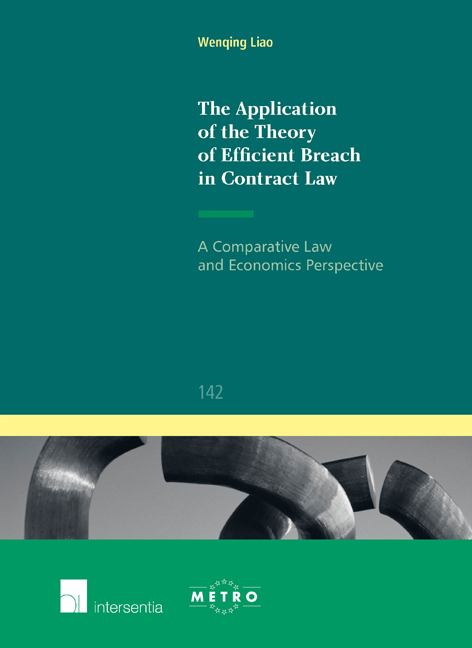 The Application of the Theory of Efficient Breach in Contract Law
The Application of the Theory of Efficient Breach in Contract Law Book contents
- Frontmatter
- Acknowledgements
- Contents
- List of Abbreviations
- List of Tables
- Chapter 1 Introduction
- Chapter 2 Economic Analysis of Contract and Contract Law
- Chapter 3 Efficient Breach in Law and Economics Theory
- Chapter 4 A Re-Examination of the Optimal Rule to Enhance Efficiency
- Chapter 5 Alternative Remedies and Efficient Breach
- Chapter 6 Efficient Breach and European Union Contract Law
- Chapter 7 Efficient Breach and Re-Negotiation in English Sales Law
- Chapter 8 Applying the Efficient Breach Doctrine to Chinese Commercial Sales Law
- Chapter 9 A Comparative Law and Economics Analysis of Efficient Breach in English Law, EU Law and Chinese Law
- Chapter 10 Concluding Remarks and Policy Recommendations
- References
- Table of legislation and European or international instruments
- Cases
- Valorization Addendum
- Ius Commune Europaeum
Chapter 5 - Alternative Remedies and Efficient Breach
Published online by Cambridge University Press: 12 December 2017
- Frontmatter
- Acknowledgements
- Contents
- List of Abbreviations
- List of Tables
- Chapter 1 Introduction
- Chapter 2 Economic Analysis of Contract and Contract Law
- Chapter 3 Efficient Breach in Law and Economics Theory
- Chapter 4 A Re-Examination of the Optimal Rule to Enhance Efficiency
- Chapter 5 Alternative Remedies and Efficient Breach
- Chapter 6 Efficient Breach and European Union Contract Law
- Chapter 7 Efficient Breach and Re-Negotiation in English Sales Law
- Chapter 8 Applying the Efficient Breach Doctrine to Chinese Commercial Sales Law
- Chapter 9 A Comparative Law and Economics Analysis of Efficient Breach in English Law, EU Law and Chinese Law
- Chapter 10 Concluding Remarks and Policy Recommendations
- References
- Table of legislation and European or international instruments
- Cases
- Valorization Addendum
- Ius Commune Europaeum
Summary
Since the legal remedy rules are able to put a price on breach, then they can alter the incentives of the party who regrets entering into a contract, which will affect the probability of breach. In a simple model, it is assumed that the higher the extent of the remedy, the more costly the breach and the weaker the parties’ incentives to breach. According to Shavell, a high damage measure, even punitive damages measure is the best if a contract is completely drafted on the basis of the parties’ rational decisions and there are no transaction costs. In a completely specified contract which is established by the consensus of the parties, performance would always be efficient and a high level of remedy would give full guarantee for performance. Nevertheless, most contracts in the real-world are incomplete and transaction costs exist within transactions. In this sense, a moderate level of remedy is considered to be efficient.
This chapter will answer how different contract remedy models can affect efficient breaches and efficiency when the elements of economic surplus, transaction costs, just compensation as well as risk allocation are all taken into account. The question will be addressed of how different remedy rules will deal with a situation where performing the original contract is inefficient. As is mentioned in chapter 4, remedies of contract can be presented in the form of either making a person who breaches perform the contract specifically or making him pay an amount of money. Following this logic, section 1 will develop the comparison between specific performance and expectation damages. It will be structured by analysing these two types of remedies within contexts of a contract to produce a product and a contract to convey a product respectively. Subsequently, section 2 and 3 will focus on monetary remedies. Specifically, section 2 will make a distinction among different types of monetary remedies which is defined by law, including restitution, reliance damages, expectation damages and disgorgement.
- Type
- Chapter
- Information
- The Application of the Theory of Efficient Breach in Contract LawA Comparative Law and Economics Perspective, pp. 89 - 130Publisher: IntersentiaPrint publication year: 2015


